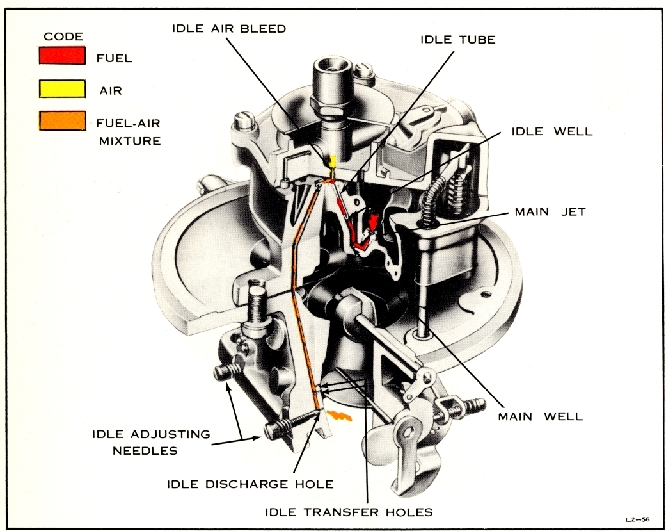
IDLE SYSTEM
3. IDLE SYSTEM
At normal cruising speeds, venturi
vacuum
causes the main metering system to
discharge
fuel.
However, at idle and low speeds, the
engine
does not draw sufficient air through
the venturi
to create a vacuum strong enough to
operate the
main metering system. The idle system
provides
the required fuel for efficient operation
while low
speed or idle conditions exist. At
idle and low
speeds, intake manifold vacuum is
high, due to
the almost closed throttle plates
which greatly
restrict air flow into the manifold.
This high
manifold vacuum provides a pressure
difference
which will operate the idle system.
In this dual carburetor are two identical
idle
system passages, one for each barrel
of the car
buretor. Since the two passages function
identi
cally, only one side will be considered
in this
explanation. At idle, the normal air
pressure in
the float chamber causes fuel to flow
through the
idle system to the greatly reduced
pressure area
below the throttle plates. Fuel flows
from the
float chamber through the main jet
and into the
bottom of the main well. From the
main well, it
flows into the idle well. The fuel
moves upward
through the idle tube in the idle
well and passes
into the idle passage in the main
body.
The cali
brated restriction in the lower tip
of the idle tube
and the restriction in the top of
the idle passage in
the main body meter the flow of fuel
in the idle
system. Directly above the horizontal
channel at
the top of the idle passage in the
main body is the
idle air bleed. This air bleed admits
a metered
flow of air to the idle system. The
idle air bleed
also acts as a vent to the idle system
to prevent
any siphoning effect at high speeds
or when the
engine is stopped. The fuel continues
down the
